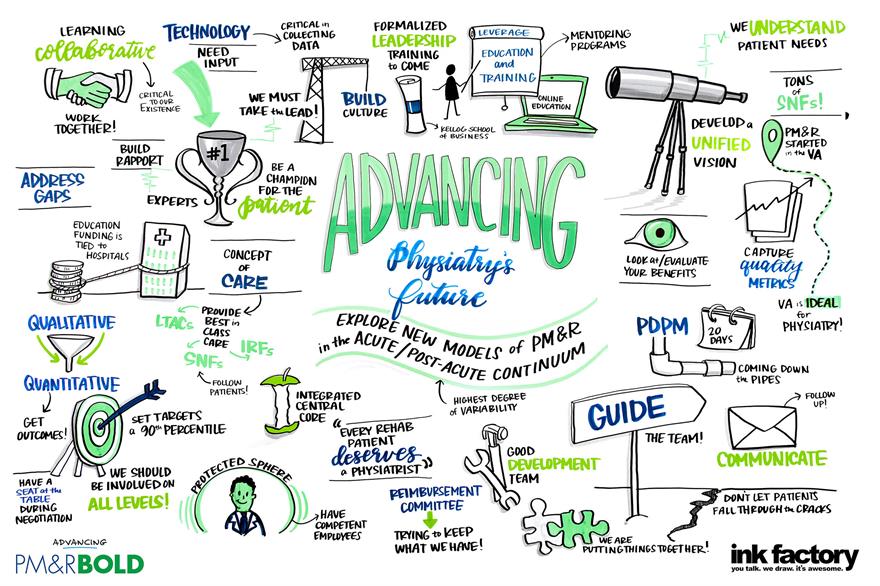The vision for the specialty offers exciting new opportunities for physiatry and will be realized in different ways across the field's diverse practice settings. To help move the vision forward, AAPM&R has enlisted the assistance of member physiatrists to develop envisioned futures for practice areas addressing this key question:
How will practices look different in the future when aligned with this vision?
In Rehabilitation Care Continuum settings, member physiatrists developed the following envisioned future based on the input from thousands of physiatrists:
In the Future ... The physiatrist is the recognized leader across the Rehabilitation Care Continuum with expertise in managing utilization of resources to achieve maximal patient outcome.
In the acute setting, physiatric involvement that focuses on impairment in addition to diagnoses and acute management of conditions reduces costs while concurrently improving outcomes and patient experiences. Early physiatric intervention in acute care offers every patient a baseline assessment of critical function and enhances appropriate post-acute care management. The physiatrist develops care pathways, co-manages models for high acuity patients, and manages post-acute provider networks. Physiatrists determine the appropriate post-acute settings based on individual patient needs and desired outcomes.
Patients benefit from the physiatrist’s focus on getting them to the appropriate setting and functioning optimally. The physiatrist is involved with the patient directing rehabilitation and managing post-discharge care from the time the patient is early in the acute care hospitalization through the Post-Acute Care continuum. As the patient population requiring rehabilitation services increases and as patients are cared for in multiple settings, there is a need for the physiatrist to provide care in those settings including inpatient rehabilitation facilities, skilled nursing facilities, long-term acute care hospitals, etc. Physiatric management of timely and efficient transitions decreases lengths of stay and hospital readmissions, improves efficiencies, reduces potential medical errors, minimizes unnecessary tests, reduces patient anxiety, and improves compliance.
Enhanced value of physiatry to health systems and patient outcomes drives increased physiatrist satisfaction and reinvigorates the workforce supply.

Image Source: This mural was drawn live during the "Advancing Physiatry's Future: Explore NEW Models of PM&R in the Acute/Post-Acute Care Continuum" session at the 2018 Annual Assembly. It captures the panel discussion and ideas shared. View a recording of the session here.
What will this look like in practice?
We are looking to develop and document three identified models that ensure appropriate physiatric care early and across the continuum of patient care.
- Model 1: Establish physiatric leaders in different settings across Post-Acute Care including but not limited to inpatient rehabilitation, skilled nursing facilities and long-term acute care hospitals
- Model 2: Integrate physiatrists in inpatient acute care settings to provide early functional evaluation and
recommendations
- Model 3: Establish physiatrists as critical leaders in managing patient transitions across the continuum of care
How will the Academy be prioritizing and supporting this?
Our prioritized objectives in Rehabilitation Care Continuum settings where we are focusing member efforts and resources to support them are:
- Establish PM&R as a critical specialty in different Rehabilitation Care Continuum settings.
- Highlight attractive opportunities for physiatrists across the Post-Acute Care continuum.
- Expand physiatrists’ reach, impact, and leadership opportunities through work with Advanced Practice Providers (APPs).
- Address educational needs for in-training physiatrists including greater exposure across the care continuum, and support the educational needs of the physiatrist in practice.
Learning Collaboratives
The Rehabilitation Care Continuum Learning Collaborative is your place to connect and learn from other members. Join the community today to hear the experiences of your peers and provide your input. Learn more about learning collaboratives here.